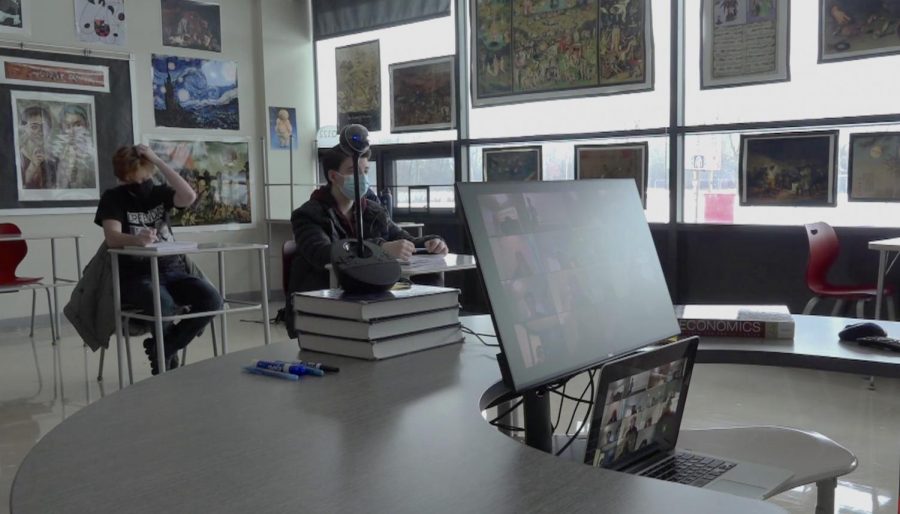How Remote and Hybrid Learning Has Impacted Special Needs Students
February 10, 2021
On February 1, the decision was made by the District 113 School Board. Some of us are going back to school for hybrid learning. February 23, the day hybrid learning goes into effect, marks the beginning of the end of a tumultuous and difficult era for students at DHS. It was especially challenging for students with learning disabilities, issues with executive functioning, or IEPs, and all manners of special education support. Hybrid learning, and increased amounts of in-person instruction in general, could turn the tide. But not for everyone.
For the many students struggling academically, remote learning is a massive challenge. Sophie Levitt, a senior at DHS, is diagnosed with ADHD. This can make learning, remote learning especially, extremely difficult for her. The unique practices of remote learning, like asynchronous classes, became a problem, or as she explained, “I’ll get so focused on a project during asynchronous learning that I end up missing my next class and don’t notice until the class is already over.” It’s the lack of structure that is so difficult for students like her. Self-guided work and difficult-to-follow Zoom lectures do not meet the level of organization that many struggling students need. It’s clear that institutional support is necessary.
Dr. Tiffany Rowe, Assistant Superintendent for Student Services, explains how interventions for struggling students operate. There’s a multi-tiered system consisting of Tier 1, support at the level of the general education teacher in the particular subject, Tier 2, school resources like the Learning Assistance Program (LAP) or the ARC, and Tier 3, typically the more intense method of special education. Dr. Rowe explained that the focus this year was strengthening the teacher-level assistance, saying, “How do we check in to make sure that we’re not just teaching content but that we are also teaching kids? That’s been our focus this year: to try to drill down to providing support at the Tier 1 level, whether a student has an IEP or not.” Students have noticed it, too; Levitt gratefully remarked, “My teachers have been quite accommodating and it’s very much appreciated. Most of my teachers have… reached out to me specifically about how they can help.” Other forms of academic support definitely require an in-person connection.
In the fall and in recent weeks, students who were not meeting their IEP goals could come into the building. Between those times, however, Dr. Rowe lamented, “when the numbers and the transmission rates climbed, we were shut down.” Simply put, being outside the school building puts one outside the District’s capacity to fully support them.
Yet, the future looks bright. Hybrid instruction is planned to begin on February 23, bringing more students in District 113 than ever into the actual school building during the pandemic. What will this do for students that are struggling? For starters, it reestablishes the way that students are supposed to be learning. “That’s where students should be: the building,” and Rowe added, “the majority of students learn best in person and when they have that support and connection with their teacher. Proximity is huge.” For kids with learning disabilities coming back to school, there will undoubtedly be benefits. For others, this transition may be unexpectedly deleterious.
Due to the nature of hybrid classrooms, teachers often have to choose between putting their best foot forward for the students physically in front of them or for the students on the screen. Usually, the focus is on students in the room. The problem occurs when struggling high schoolers are unable to come to the building and thus receive, to put it mildly, the short end of the stick. Comorbid conditions (ailments that commonly appear alongside one another), familial obligations, and living situations can all prevent a student from coming to school. Levitt found that many of the District’s options for support cannot help her, stating that, “I know that the school has attempted to provide resources for students and such, but a solid amount of the issues I encounter are ones that it is unable to handle.” Hybrid learning in particular won’t be effective for her situation as Levitt currently resides in Arizona. Student Services acknowledges this challenge, Dr. Rowe explained. “We have many kids who have comorbid conditions who may have a disability and some medical condition that prohibits them from being in the building for one reason or another. I think we’re all doing the best we can to reach out to those students.”
Even for those who can come to school, the significant challenges of the hybrid in-person classroom with full PPE and other mitigations can be disillusioning to many students, particularly in special education. This effect manifested in District 113 earlier in the school year when Dr. Rowe noticed this issue, finding that “It can be very overwhelming for everyone to be wearing masks and six feet apart and it doesn’t feel like real school.” Real examples of this occur, such as during special education’s in-person instruction in the fall. “We saw students who might have come a couple of days before deciding ‘I’d rather have this at home, it’s too difficult, it’s not what I thought it was going to be,’” Dr. Rowe recounted. Among general education hybrid models, Dr. Rowe pointed out a recurring problem: “There is a pattern we’ve seen throughout all the districts who have had hybrid learning: Students come in, and then many of them drop off.” When these students go home, they get the aforementioned short end of the stick.
All in all, in order for District 113 to adequately provide services to students with learning disabilities, it needs to bring them into the building. For many students, that remains unwanted or impossible. So, with the hybrid transition rapidly approaching, the District must take care to avoid making the situation worse. It’s a Catch-22; the remote status quo is problematic but the hybrid future must be approached with caution.


